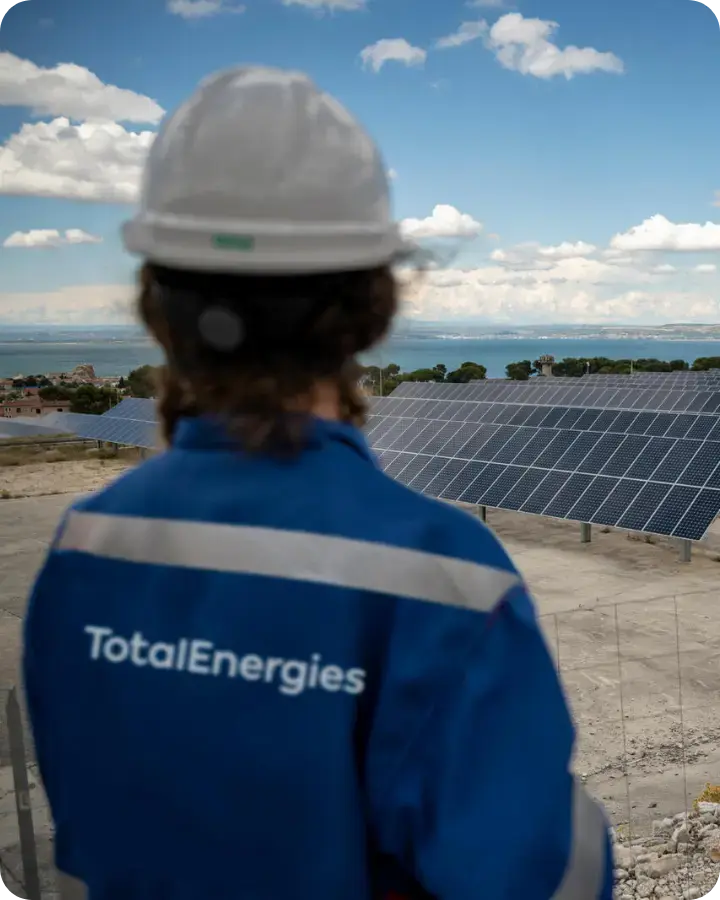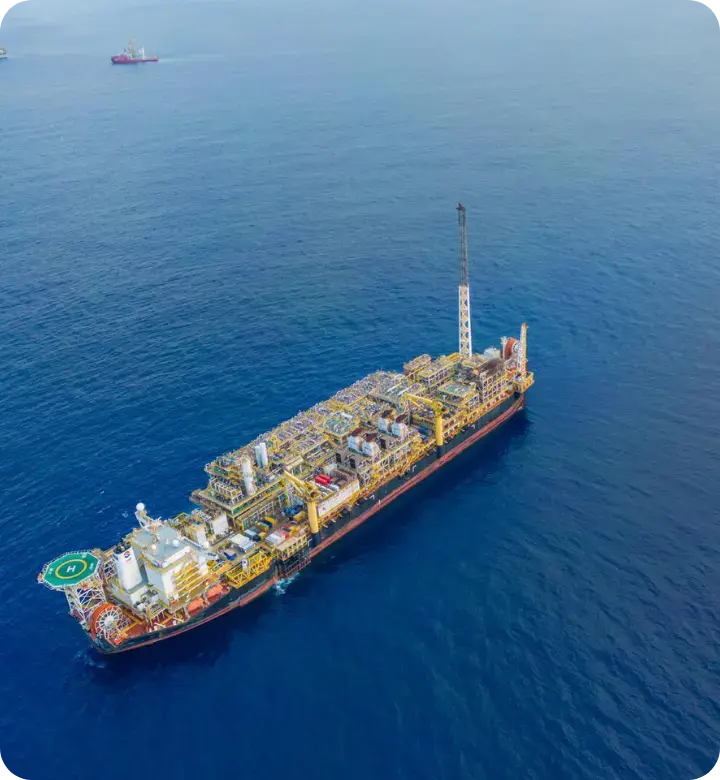
Building a Multi-Energy Company
Our ambition
In affirming its ambition to be a major player in the energy transition and to achieve carbon neutrality by 2050, together with society, TotalEnergies has committed to profoundly transforming its production and sales while continuing to meet the energy needs of a growing population.
To do that, we are reinventing and diversifying our energy offering to promote renewable and decarbonized energies, as well as sparing, well-considered use of fossil energies. Since the beginning of the decade, we have moved resolutely to transform our energy model in order to become a multi-energy company and major player in the energy transition.
In 2050, TotalEnergies would produce:

- About 50% of its energy in the form of electricity including the corresponding storage capacity, totaling around 500 TWh/year, on the premise that TotalEnergies would develop about 400 GW of gross renewable capacity;
- Around 25%, or the equivalent of 50 Mt/year of low-carbon energy molecules, either in the form of biogas, hydrogen or synthetic liquid fuels from the circular reaction: H2 + CO2 (“e-fuels”);
- Around 1 Mboe/day of Oil & Gas (about a quarter of the production in 2030, consistent with the decline envisaged by the IEA’s Net Zero scenario), primarily liquefied natural gas (about 0.7 Mboe/d, or 25-30 Mt/year) with very low-cost oil accounting for the rest. Most of that oil would be used in the petrochemicals industry to produce around 10 Mt/year of polymers, of which two thirds would come from the circular economy.
To achieve our ambition of carbon neutrality by 2050, together with society,
we have set ourselves global greenhouse gas emission reduction targets,
with intermediate objectives for 2025 and 2030.

1. Our emissionsAchieve by 2050 or earlier carbon neutrality (net zero emissions) for our operated activities (Scope 1+2) with intermediate targets of
| 
2. Carbon footprint of products soldAchieve by 2050 or earlier carbon neutrality (net zero emissions) for indirect GHG emissions related to our customers’ use of energy products (Scope 3), together with society. Our intermediate targets compared to 2015 are to:
|
Offsetting residual emissions with natural carbon sinks

Natural areas preservation and restoration can be a lever for achieving net zero emissions worldwide by 2050.
Voluntary offsetting of residual emissions with NBS (Nature Based Solutions) carbon credits will only be used from 2030, to offset Scope 1+2 residual emissions.
That’s why we invest in natural carbon sinks – ecosystems that naturally sequester carbon – through forestry, regenerative agriculture and wetland protection projects.
More Energy, Less Emissions
Sustainability & Climate 2025 Progress Report
March 2025
target to reduce our sales of petroleum products by 2030 compared with 2019
Gas


For TotalEnergies, natural gas is a key energy for the energy transition. As a fossil fuel, it emits half as much greenhouse gas as coal when used to generate electricity. This abundant and easily accessible energy source makes it a valuable ally in helping coal-dependent countries reduce their greenhouse gas emissions.
In the gas markets, TotalEnergies focuses on Liquefied Natural Gas (LNG), which can be shipped anywhere in the world and thus contributes to energy security, as it has been the case in Europe since 2022 with the strong reduction of Russian pipeline gas deliveries.
With diversified positions, and in particular its leading position of exporter in the United States - over 10 Mt in 2023 - TotalEnergies is the 3rd world’s largest LNG player, with 44 Mt sold in 2023. TotalEnergies aims to gradually reduce GHG emissions of the LNG value chain, from gas production to end use.
Methane is a greenhouse gas with a global warming potential 30 times higher than that of CO2 and a much shorter atmospheric lifetime. At the beginning of 2022, we set ourselves some concrete and very ambitious targets for the next decade: -50% in 2025 and -80% in 2030, compared with 2020. These targets cover all of the Company's operated assets and go beyond the 75% reduction in methane emissions from Oil & Gas by 2030 (vs 2020) as recommended by the IEA when creating the NZE scenario. We are also strengthening our methane intensity target of less than 0.1% by 2030 on our gas facilities, by extending it to all our operated Upstream Oil & Gas facilities.
In 2023, our operated methane emissions were 34 kt, down 47% vs 2020. TotalEnergies now aims to reach its 2025 target of -50%, one year ahead of schedule, in 2024.
An integrated global LNG player

More Energy, Less Emissions
Sustainability & Climate 2025 Progress Report
March 2025
Renewable electricity (wind and solar)


We are continuing to expand in the renewable energies market (wind and solar), with the aim of becoming one of the world’s top five producers of renewable electricity. Our goal is to produce 100 TWh/year of electricity by 2030.
Our target for gross installed renewable energy capacity (worldwide) in 2025 is secure, and we are already working on projects to reach our goal of 100 TW/y by 2030. The acquisition of 100% of Total Eren’s capital in 2023 and its integration within the company will contribute to this.
The intermittent nature of solar and wind projects creates a need for flexible generation and storage capacity to meet demand at all times and guarantee grid reliability.
Our portfolio of controllable power generation from gas-fired plants reached a capacity of 5.6 GW in 2022. Eventually, these capacities will be decarbonized, either through their supply (biomethane or low-carbon hydrogen), or through the sequestration of their CCS emissions.
For storage, we rely on Saft’s technological expertise. Our goal for 2030: 5 GW of storage capacity deployed worldwide.
Electricity production target for 2030
of storage capacity deployed worldwide by 2030

Biomass
Vegetables oils, used cooking oils, animal fats fo biofuel production, organic waste for biogas production... Biomass is a renewable energy source of the future, enabling the development of low-carbon molecules. It is now an immediately available solution for rapidly reducing the carbon footprint of mobility and replacing natural gas. A real challenge, since by 2030, the share of renewable energy used in transport will have to reach 14% in the European Union
Expanding our biofuels offering

Today, biofuels emit less than 50% of the CO2 equivalent of fossil fuels over their life cycle, and therefore represent a way of decarbonizing liquid fuels.
Among these biofuels, we favor the manufacture of Sustainable Aviation Fuels (SAF) for the decarbonization of the aviation sector, while the road sector has options other than biodiesel for decarbonization, notably electricity.
To avoid land-use conflicts, we develop solutions based on the priority use of waste and residues from the food industry. The agricultural raw materials used comply with sustainability and traceability requirements: carbon footprint, non-deforestation and effective land use.
In 2022, we stopped sourcing palm oil and its derivatives and have set a new target of increasing the share of circular feedstocks (used oils, animal fats) to over 75% of the feedstocks used to produce biofuels by 2024.
Accelerating in biogas

Biogas, produced by the degradation of organic waste, is a renewable gas composed mainly of methane. Compatible with existing gas transmission and storage infrastructures, it has an important role to play in decarbonizing the use of gas products (power generation, heating).
In this essentially local market, we are rapidly gaining momentum. Our objective is to achieve a biomethane capacity of 2 TWh/year by 2025 and 20 TWh/year by 2030 worldwide.
To this end, we are forging strategic partnerships with players in the agricultural, waste and wastewater treatment sectors to develop growth platforms in Europe and the United States.
global biomethane capacity target for 2030
Hydrogen


Hydrogen acts as a gateway between a primary energy source and its end uses. We are interested in the production of more low-carbon hydrogen, which concerns:
- Renewable hydrogen (commonly known as “green hydrogen”), produced either by electrolysis using electricity from renewable energy sources, or by any other technology using exclusively one or more of these same renewable energy sources and not conflicting with other uses enabling their direct valorization.
- Low-carbon hydrogen (commonly known as “blue hydrogen”), produced by converting fossil fuels, but whose CO2 emissions are captured for reuse or storage, using carbon capture and storage (CCS) processes. Low-carbon hydrogen also refers to hydrogen produced by electrolysis, using electricity from low-carbon energy sources, notably nuclear (commonly referred to as “yellow hydrogen”), with a significant reduction in greenhouse gas emissions over the entire life cycle compared with hydrogen produced using existing techniques.
To meet our ambition of achieving carbon neutrality by 2050, together with society, we are working with our suppliers and partners to decarbonize all the fossil fuel hydrogen (commonly known as “gray hydrogen”) consumed in our European refineries and biorefineries by 2030. This effort aims to reduce CO2 emissions by 3 million tons a year.
The hydrogen production capacities currently under development will contribute to our ambition of increasing new molecules – biofuels, biogas, hydrogen and e-fuels** – to 25% of our energy production and sales by 2050.
Through these projects, we aim to position ourselves as a pioneer in the mass production of renewable, low-carbon hydrogen to meet growing demand. This ambition will be particularly necessary to help decarbonize heavy mobility.
More Energy, Less Emissions
Sustainability & Climate 2025 Progress Report
March 2025

Road transport
We offer our customers solutions to accelerate the adoption of electric mobility:
- Deployment of charging infrastructure, with a worldwide target of 150,000 charging points in operation;
- Ipgrading to high-power charging solutions on freeways, with a target of 700 European sites equipped by 2025;
- Production of batteries for electric vehicles
The marketing of CNG (based on natural gas or biogas) and biofuels makes it possible to take action on greenhouse gas emissions from the existing vehicle fleet, without waiting for the market share of electric vehicles to increase. Thanks to our European biorefineries, we can offer our customers HVO (hydrotreated vegetable oil), a fully bio-based biodiesel that can reduce CO2 emissions by 50-90% compared with conventional fuel.
Hydrogen is another mobility solution whose development we are supporting, particularly for heavy goods vehicles.

Air transport
One of the main levers for decarbonizing the air transport sector is the integration of SAF. These offer up to 90% reduction in CO2 emissions over the entire life cycle. We have set ourselves the target of reaching 10% global SAF sales by 2030, and are working with all players in the value chain, from suppliers of bio-based raw materials to customers who incorporate SAF into aircraft.

Maritime transport
To reduce the emissions of our maritime customers, we are committed to supplying LNG (with a target of 10% of the global market by 2030), bio-LNG and biofuels at strategic bunkering centers. In the long term, we are working with partners in maritime coalitions and cross-sector R&D initiatives to shape the market for future decarbonized shipping fuels (advanced biofuels, biomethane, green methanol and synthetic ammonia).
Residential, tertiary and industrial uses

Our integration across the electricity value chain extends right through to end-customer sales, with tailored offers for both residential and business customers. By the end of 2022, we will be selling electricity and natural gas in the residential and professional segments to 9 million customers in Europe. By 2030, we aim to supply nearly 10 million customers and sell 130 TWh of electricity a year.
electricity sales target by 2030
More Energy, Less Emissions
Sustainability & Climate 2025 Progress Report
March 2025

